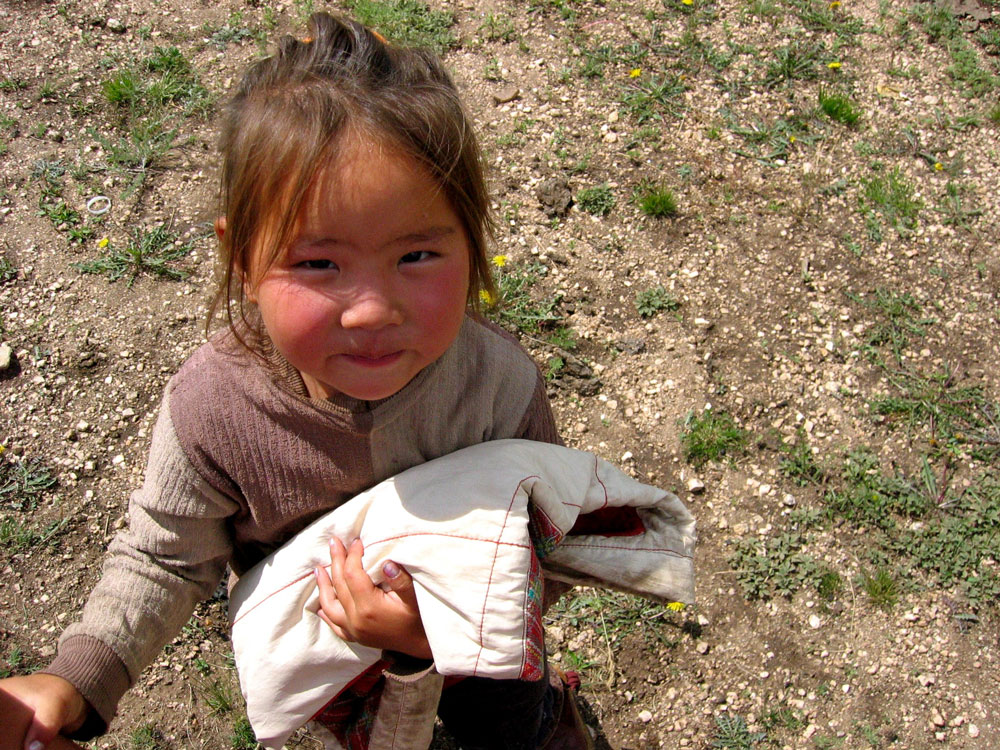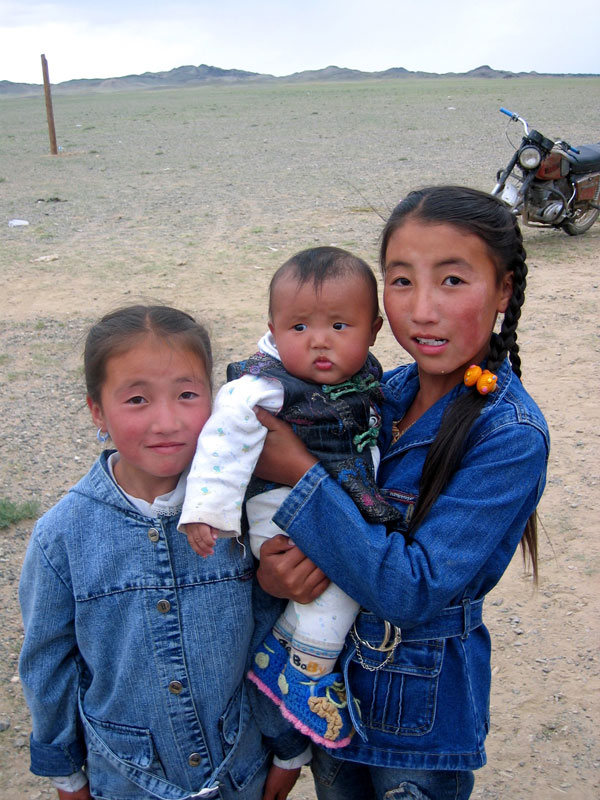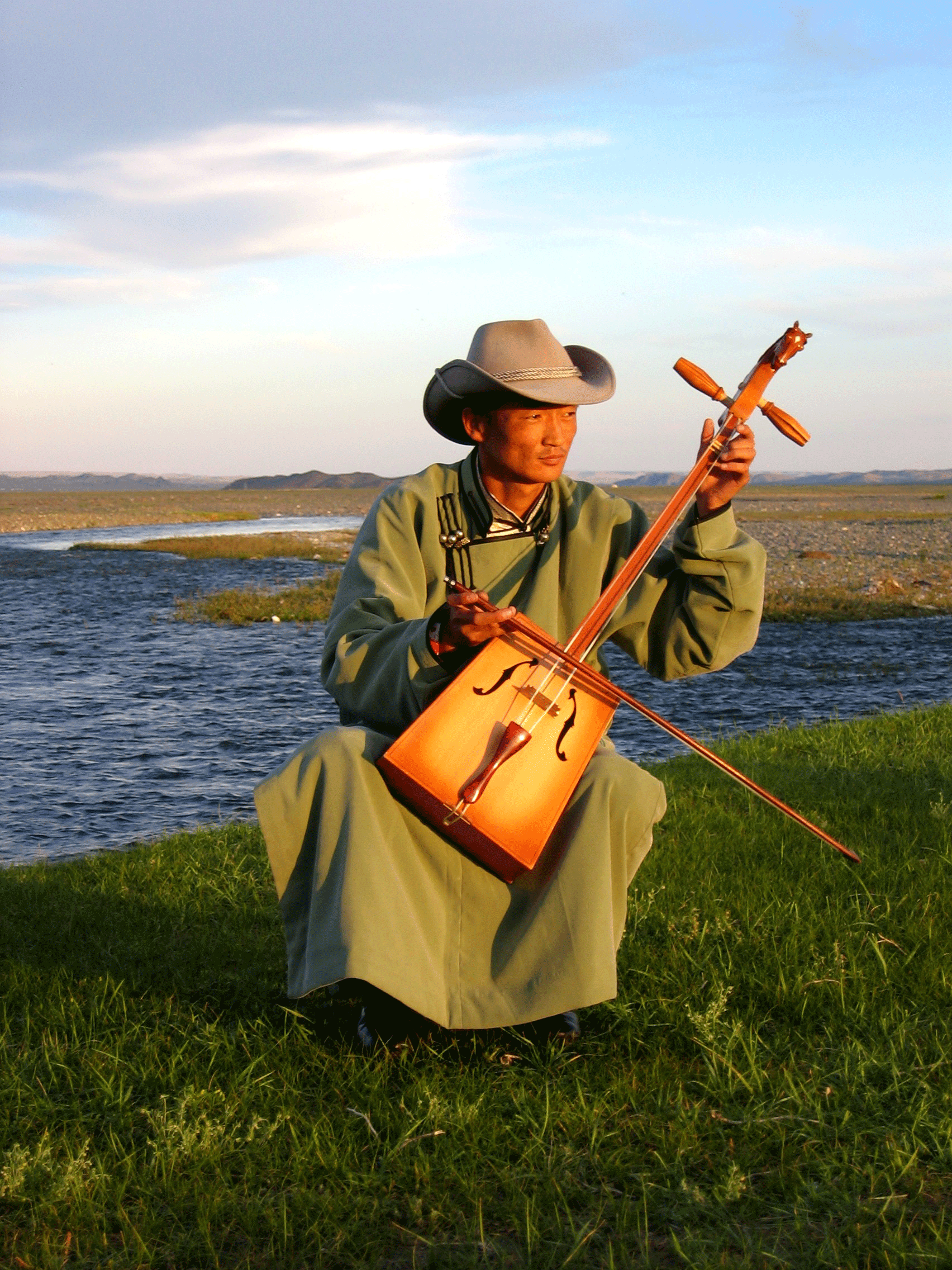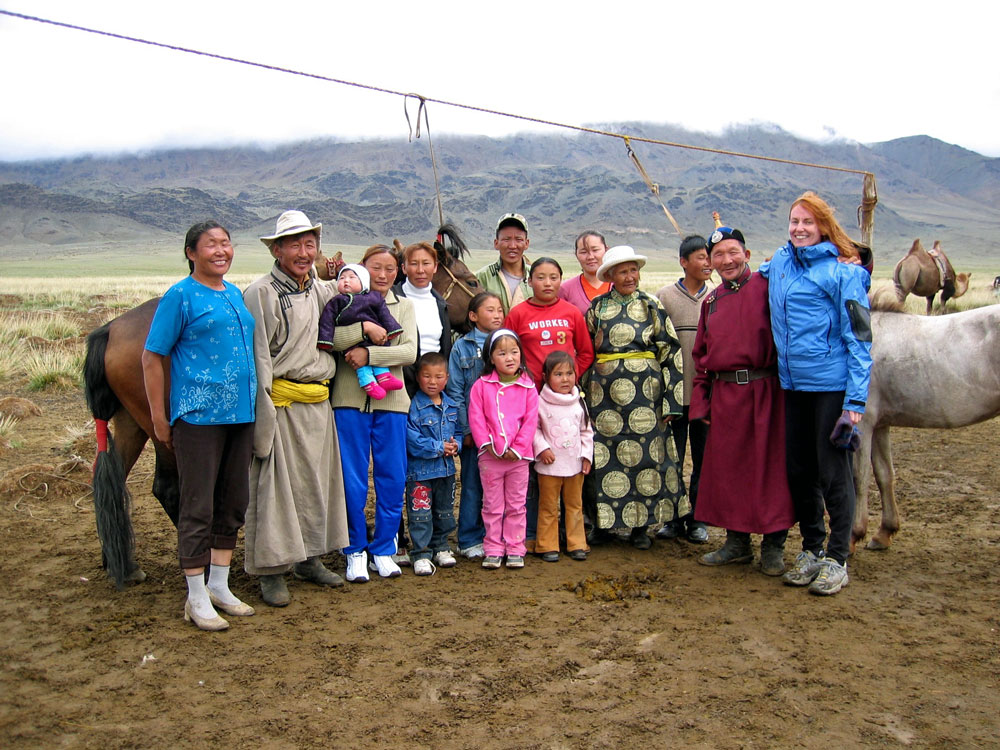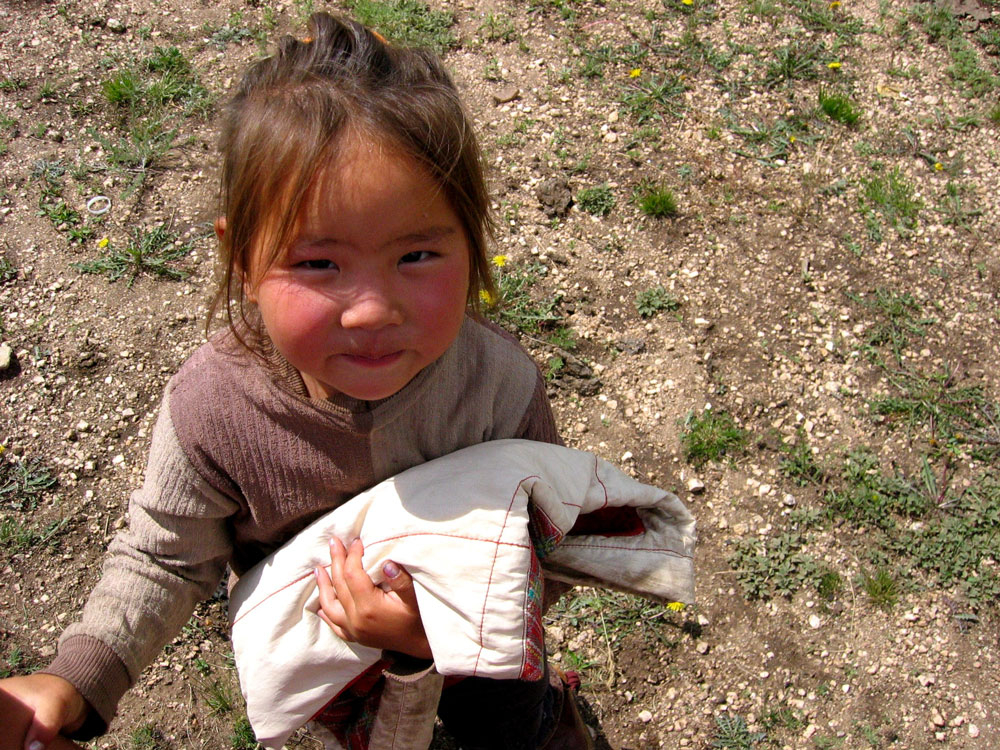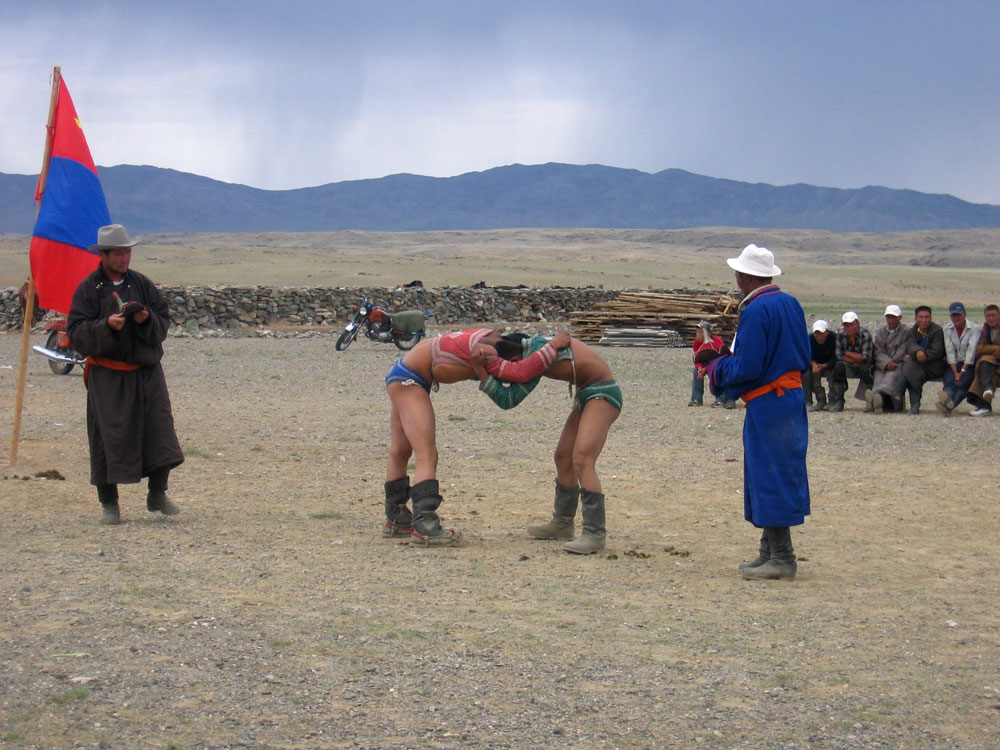This was a rather loosely planned trip. Rather, we didn’t know what the plans really were. We did know we were going to Mongolia, however. Most of the arrangements had been made by Mary, a Michigan woman whom Susan had not met but had contacted through her weavers’ network. Here is the story. As Mark Twain said in a different context: some of it is true.
There are no direct flights, so we went straight to Beijing. Thirteen hours in a full 747. Once there, we headed for the standard destinations. Tiannemen Square is enormous and overwhelming (try to ignore its recent history). The Forbidden City is a massive expanse of ancient temples. They are very impressive, although some are in bad repair. Restoration is being assisted by American Express, which has its blue logo brightly displayed on every descriptive panel. Visiting Chinese families with elaborately dressed little girls, using the old building as photo backdrops. Should you need refreshment, there is a Starbucks in the southeast corner. [This Starbucks has a curious history. It was founded during the Q’ing dynasty by Wai-ling Starbuck, a distant ancestor of the first mate on Melville’s Pequod. A century later it was suppressed by tea merchants, but made a comeback under the caffeine-loving emperor Reglof. All Starbucks franchises were destroyed under Mao’s rule. Their latest comeback has been led by George W. Starbuck, who plans to diversify into petroleum products.]
We stayed at the Lu Song Yuan hotel, on a little lane half a mile north of the forbidden city. Quite comfortable and not too Western. It was a fascinating area, unlike others that are being demolished for the 2008 Olympics. We were the only Westerners on the streets, and no one tried to sell us anything. The food was excellent.
Most impressive of all was the Great Wall. We chose the Mutianyu access, about 60 miles northeast of the city. The wall is truly spectacular here, looping and arching over high forested hills. Every few hundred yards is a sentry block, just as you have seen in photos. Even though the wall was not very good at keeping out barbarians, it is an amazing sight. In this hilly section, it is also something of a hike. The spectacle was (somewhat frighteningly) enhanced by a thunderstorm, which swept in with fury. (Note: many sections of the wall are unrestored and off-limits.)
I wish we had more time at the wall. Our tour van did not collect us until 11:30. The trip was bizarre. One fellow tourist had already boarded: a young Canadian man who had been teaching in the country. He seemed eager to antagonize the guide, who merely asked him for the voucher of payment for the trip. “I don’t have a voucher.” “That is very bad. You must have a voucher.” “But I don’t.” “Then what are you doing here?” “Waiting to go to the Great Wall. Just like you.’
Susan told him that he was speaking to the guide, which he had seemed not to realize, whereupon he became almost friendly and produced the voucher. Meanwhile we helped the guide with his English, explicating such expressions as “Hitch a ride” and “This sucks.” We then drove all over the city to pick up a two Chinese men who had refused to come to a more convenient point, as well as a young woman with a blonde pigtail. She looked very sullen, perhaps because she had been waiting an hour and a half. She said she was from Hong Kong. She sat in the back of the man and occasionally broke in on the guide’s spiel to educate him on the difference between “densely populated” and “heavily populated.” On arrival at the wall, she announced that she was on “a very tight time budget” and could stay only 90 minutes.” She also protested the imposition of a fee at the toilet. Susan pointed that this was common practice. “But not in the desert,” Sullen replied, oblivious of the damp trees all around us.
We did not return to the city until 7:30. Sullen had become suddenly cheerful, even though we had stretched her time budget. I, however, was morose because my wristwatch was gone. I knew just when it had been pinched: when I collided with a Chinese woman at one of the sentry posts. She must have been very skillful, because the band had a clasp. No doubt she needed it more than I did.
We were the first ones dropped off. I tumbled out of the van, followed by my broken-banded watch. I had been sitting on it the entire trip.
Once again, my birthday found me in an exotic location. I selected an enticing restaurant by a lake. It was fine once we found it, which required several circum-perambulations of the lake. By the way, don’t believe those stories that many urban Chinese speak English. Most don’t. Including cabbies.
We flew west to Ulaan Baatar (Oo-lan bat-ter), the capital of, and only real city in, Mongolia. At that time, it was the coldest capital in the world. The time was, weirdly, an hour later than Beijing’s. The population, well under a million, is about a third that of the entire, large country. It is not a beautiful place: shapeless and characterized by blocky Russian and Chinese buildings. It is, however, exotic. And there are many restaurants for us tourists, including a Mexican-Indian one. I got sick afterwards, but recommend it anyway, as the fare is very tasty. We also had lunch in the Russian restaurant in the Bayangol Hotel, where we stayed: eggs with caviar; borscht; meat and rice; fruit. Here we had another chance to see Cameron Diaz. She was in Charlie’s Angels on the overhead tv, speaking fluent Russian.
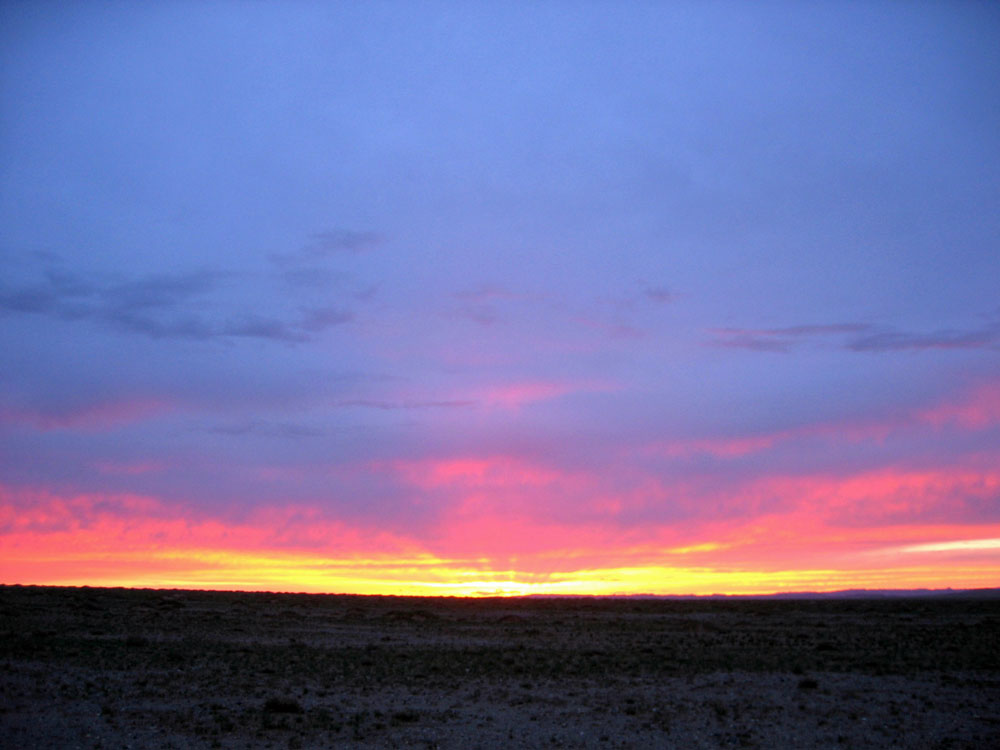
We were now in the hands of Genghis Khan Expeditions, led by Bodio and his wife Monkhtuya. Their guide/interpreter, Bode (Boo-dee), had met us at the airport. She was a tall, cheerful woman, a university student in her mid-twenties. She accompanied us on our trip to the western region, carrying several dozen raw eggs. This was our first encounter with the national airline, MIAT (Maybe It Arrives Today). We boarded, de-boarded when the propellers didn’t work right, took off several hours late.
Lowlights of subsequent flights: 1) We landed mid-flight to pick up blueberries. Then the aircraft would not re-start. It was pulled around so that the propellers faced the wind, but to no avail. Then the shout went up for TOOLS. A young man burst out of the terminal wielding a pair of screwdrivers. They did the trick. 2) At another stop, a few weeks later, the pilot’s relatives crowded on for a free ride to UB. They didn’t all fit. Nor was there room for a ticketed passenger, who threatened an appeal to the UN Human Rights Commission. This was unsettling. Once landed in the west (Khovd), we had an introduction to Mongolian country roads. Not roads, really. Tracks perhaps, or merely directions. Don’t try this with your low-slung sports car. Recommended vehicles are Russian-built 4-wheel vans and jeeps. They break down frequently, so your driver (you had better have one) must be an auto mechanic as well. With luck, you can average 15 or 20 mph. Our first attempt was a failure: the grassy track petered out among rocks, and the river was to wide to ford. A bumpy alternative of several hours brought us to our first campsite, in a valley among some barren but beautiful mountains. The place was ours alone, though we caught occasional sight of a nomad or had a horseback visitor. Besides Bode, we had an indefatigable driver and a cook, a glamorous Kazakh woman. She was dressed entirely in black. Her tank top proclaimed, “Happy Day, Let’s Go.” Her cooking was great, but mutton night after night becomes tedious. Fruits and vegetables must be imported; Mongolia appears to be the only Asian country without spices. We spent several days hiking about in the vicinity. Only one of our campsites was high and therefore cold. Here we learned that Bode was a real city girl: 1) Susan had to lend her warm clothes. 2) She had never ridden a horse. (Even I had done that.) 3) Her shoes were all wrong for boulder fields. Only one true hiking day. We stopped at 11,000 feet (who knows?), just short of the snow line.It was unlike Switzerland: nobody else in sight, no huts or teleferiques. Nevertheless, our cook later rode off with a visiting horseman to visit some in-laws living somewhere in the distance. We also had a drunken emissary allegedly from the National Park we were in. He had no identification, and Bode sent him staggering on his way. We also paid our first of many visits to a Mongolian ger (not to be confused with a yurt). These vary somewhat but usually share these characteristics:
- octagonal;
- about 20 feet across;
- made of felt;
- one door, 4 feet high, facing south;
- no windows;
- one solar panel, which powers:
- one fluorescent light bulb and one television set;
- several cots;
- numerous photos of family and Dalai Lama;
- can be disassembled in half a day and transported in a camel cart;
- elaborately painted (bright orange) woodwork;
- a haunch of lamb hanging by the door.
The day before our flight back to UB, we tried to confirm our reservations. Could not: the airport was closed that day. We did reach our destination, however, after some delay (see blueberries, above) in time to meet our Michigan travel companions, Mary and Linda. We were immediately whisked off to a folk concert: gorgeous costumes, throat singing, and the finale of Mozart’s Turkish piano sonata arranged for 8 Mongolian instruments.
The next morning we were driven some 50 miles northeast to the Gorkhi-Teralj national park, where we stayed in a ger camp: 30 or so gers designed for tourists like us. There was a giant ger-shaped dining room and a wash house with flush toilets. The setting was spectacular: lush green hills with rock outcrops. We scrambled about and visited the imposing Turtle Rock, which really does resemble a turtle if you think so.
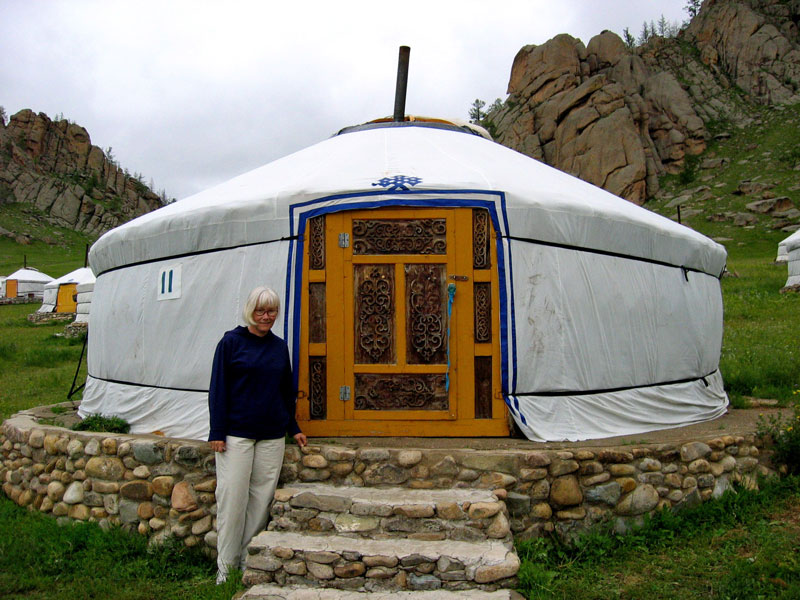
Now we were prepared for our main objective, the Gobi Desert. Another adventure with MIAT. Bode brought 15 dozen eggs as carry-on. The Gobi--at least its eastern part--is quite unlike the Sahara. No sand dunes or hot arid days. It is rocky, fairly green and has mountains to 13,000 feet. We had a pleasant campsite by a river and fell asleep around dark: 10 p.m. Next day a long, bumpy drive up an improbable rocky pass to the dwelling of Bodio’s friend, Dash. This consisted of 10 gers on a grassy plain. Other such camps could be seen a few miles off. There are no fences in rural (i.e. most of) Mongolia, and horses, goats, sheep and camels ambled about. We stayed a couple of nights and got some feel for the local way of life: late rising, tending to all the animals, eating and drinking, playing volleyball. [We competed very badly; only Bodio and Linda knew how to play this game.] We also learned how to make felt and to milk camels and mares. I was supposed to participate in an early morning round-up of horses, but this was rained out. We did, however, ride camels later that morning. All the female ones were pregnant. [Be sure to catch the recent film The Story of the Weeping Camel to see one of these creatures giving birth.] My camel, who was called Hanukkah or something like it, was slower than the others. Eventually she decided to catch up, with dire consequences for me. It is a long way from the back of a camel to the ground, especially if you land badly. I was unamused, but Dash had a great time the rest of the day imitating my discomfiture, with grimaces.
The food and drink part was intensified in our honor the second night. The drink was abundant, to the subsequent detriment of one of our party. Local favorites are fermented mare’s milk (somewhat better than it sounds), and home-made vodka. There was also singing, for which we had been told to prepare. Music is a big part of the culture. Susan recalls particularly a boy emerging from an isolated ger, singing loud.
Once recovered from the festivities, Linda and Mary set off one way on horse, we another by van. It was one of several days of multi-hour driving. We found it far from relaxing. There was no traffic, to be sure, but neither was there much road. Early evening found us at the Amarbuyant monastery. It once thrived with 1000 monks, but in 1937 fell victim to Stalin’s anti-religious slaughter. Little remains. A few buildings have been restored; the rest are ruins of mud. The current monk population is about 30, many of them currently studying in India or UB. Apart from its desolation, the place embodies the idea of remoteness--it is many hours from anywhere.
After another day spent mostly in the van, we were eager for a hike. Our two-day expedition had been happily designed to be almost entirely downhill. Thus we drove uphill a long way to meet our yaks at Porcupine Rock. Once they had both been located and saddled, we headed down, along with two horses and various helpers. The canyon that we followed was lovely and increasingly impressive as we descended. We camped at a moderately flat spot near the stream. The next day we hiked out, past a cave and waterfall, onto flatter terrain. By early evening we neared the end of the valley, where the van would be waiting for us. We arrived. Guess what?... Using Susan’s binoculars, we scanned in many directions. No van. But as in Tibet, there is always a solution in Mongolia. A horseman was dispatched upstream to fetch a jeep, the one vehicle we had passed in the last 24 hours. After several hours, it carried the six of, plus a boy and girl who had mysteriously appeared, down to supper and a camping spot near a large, shallow lake.
We will always remember that camping place. Hardly had we settled in when a pair of male voices started muttering close by. The exchange (Mongolian is approximate):
voice: Hthyiop
us: What do you want?
voice: Mrthert goolam!
us: Go away
voice: Goolam ghrwuph blunk
me: Bayartai, bayartai! [attempt to say “goodbye” in Mongolian]This all seemed fairly amusing until a flame lit up a few inches from the tent. Then we shouted for Bodio, who chased the drunkards off.
Note on the Mongolian language: The October 2004 number of Harper’s carries a useful list of clan names, including those for “collectors of dried dung,” “the great--grandchildren of the one-eyed ogre,” “the skins of animals that have starved to death,” and “those with small, hairy bodies.”
Next morning the van came to collect us--it had been unable to refuel the previous evening. [In Mongolia, places with gas stations are marked on the national map.] Soon we were back in civilization, visiting a hospital that Bodio was supporting. It was supposed to have three doctors but had only one, a young woman. Electricity was available only a few hours a day. Bodio has contributed solar panels, so women will no longer have to give birth by candlelight. [ More help is on the way: a power line and a new building.] Thence to a crafts co-op with 22 members. Susan bought a felt rug, now the first thing you see as you enter her house.
Our final big desert event was a mini-Nadaam (festival). It was held in the true middle of nowhere. One of the events was a children’s horse race. We rooted for the only girl, who placed third. The winner fell off his horse, but in Mongolia it’s the horse that matters.Then came wrestling, for which the country is famed (took a bronze at the Athens Olympics). It goes slowly and ceremoniously. The day was concluded by a disco. Because this was rumored to be in our honor, even I had to participate. On the way back, Susan had an ice-cream craving--unfulfilled because there was no electricity.
Back in UB, we caught up on news in the international Herald-Trib. (Only the Thursday edition reaches the country, so we learned little about the other days.) We also picked up the Mongol Messenger, which began publication in 1991, after the Russians pulled out. A farewell dinner at Bodio’s big new apartment and we were ready for the long trip back to Newark.
But was the trip ready for us? The MIAT officials tried to prevent us from boarding for Beijing because we had no Chinese visa (not needed in transit). We just stood there until they let us on. And changing planes in Beijing is a challenge. You have to exit the terminal, climb an outdoors staircase and re-enter on the next floor. Linda did not make it and got an extra night in the city. We arrived in Newark what seemed like several days later. Our taxi driver was not Mongolian.
